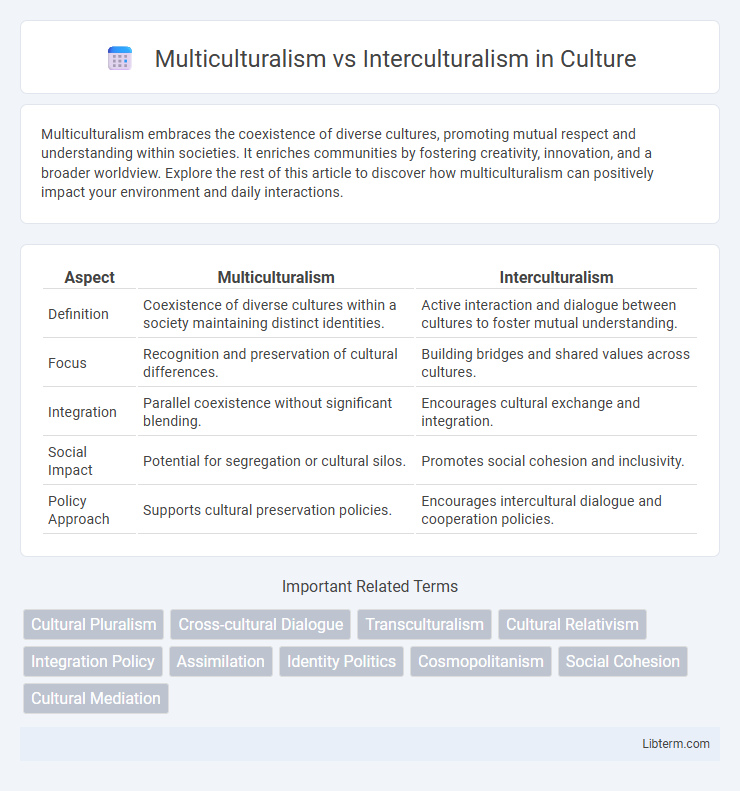Multiculturalism embraces the coexistence of diverse cultures, promoting mutual respect and understanding within societies. It enriches communities by fostering creativity, innovation, and a broader worldview. Explore the rest of this article to discover how multiculturalism can positively impact your environment and daily interactions.
Table of Comparison
| Aspect | Multiculturalism | Interculturalism |
|---|---|---|
| Definition | Coexistence of diverse cultures within a society maintaining distinct identities. | Active interaction and dialogue between cultures to foster mutual understanding. |
| Focus | Recognition and preservation of cultural differences. | Building bridges and shared values across cultures. |
| Integration | Parallel coexistence without significant blending. | Encourages cultural exchange and integration. |
| Social Impact | Potential for segregation or cultural silos. | Promotes social cohesion and inclusivity. |
| Policy Approach | Supports cultural preservation policies. | Encourages intercultural dialogue and cooperation policies. |
Understanding Multiculturalism: Key Concepts
Multiculturalism emphasizes the coexistence of diverse cultural groups within a society, recognizing and preserving distinct cultural identities and promoting equal respect for all cultures. It centers on cultural pluralism, collective rights, and the celebration of cultural diversity as a societal asset. Key concepts include cultural recognition, social inclusion, and the protection of minority languages and traditions to foster an environment of mutual respect and equality.
Defining Interculturalism: An Evolving Perspective
Interculturalism emphasizes dynamic interaction and dialogue between diverse cultural groups, prioritizing mutual respect and understanding over mere coexistence. Unlike multiculturalism, which often highlights the preservation of distinct cultural identities within a society, interculturalism seeks integration through active communication and shared experiences. This evolving perspective promotes social cohesion by encouraging cultural exchange and adaptability in increasingly diverse environments.
Historical Origins of Multicultural and Intercultural Models
Multiculturalism originated in the 1960s and 1970s as a response to ethnic and cultural diversity in Western societies, emphasizing the coexistence of distinct cultural groups within a single nation-state. Interculturalism emerged later as a critique of multiculturalism, focusing on fostering dialogue, interaction, and integration between cultural communities to promote social cohesion. The historical shift from multiculturalism to interculturalism reflects changing social dynamics and policy priorities aimed at enhancing mutual understanding and reducing societal fragmentation.
Core Differences Between Multiculturalism and Interculturalism
Multiculturalism emphasizes the coexistence of diverse cultural groups within a society, recognizing and preserving distinct cultural identities without necessarily encouraging deep interaction. Interculturalism promotes active dialogue, interaction, and integration between cultural groups to build shared values and social cohesion. The core difference lies in multiculturalism's focus on cultural pluralism and coexistence, while interculturalism stresses communication, mutual understanding, and exchange among cultures.
Policy Approaches in Multicultural vs Intercultural Societies
Multiculturalism policies emphasize the recognition and preservation of distinct cultural identities within a society, promoting equal rights and the coexistence of diverse groups without necessarily encouraging interaction. Interculturalism prioritizes active dialogue and exchange between cultures to foster social cohesion and shared values, often implementing integrative programs that encourage collaboration and mutual understanding. Policy approaches in multicultural societies tend to focus on legal protections and cultural rights, while intercultural societies pursue dynamic engagement strategies to build inclusive communities.
Social Integration: Contrasting Strategies and Outcomes
Multiculturalism emphasizes the coexistence of diverse cultural groups within a society, promoting cultural preservation and equal recognition but often resulting in parallel communities and limited social integration. Interculturalism advocates for active dialogue and interaction between cultural groups, fostering shared values and social cohesion through mutual understanding and collaboration. This approach generally leads to stronger social integration, reducing ethnic segregation and enhancing collective identity while respecting cultural diversity.
Challenges Faced by Multicultural and Intercultural Frameworks
Multicultural frameworks often struggle with segregation and lack of meaningful interaction between cultural groups, resulting in social fragmentation. Interculturalism faces challenges in fostering genuine dialogue and balancing the power dynamics among diverse communities while promoting shared values. Both approaches must address issues of inclusion, representation, and overcoming prejudice to create cohesive and equitable societies.
The Role of Education in Promoting Cultural Dialogue
Education strengthens multiculturalism by acknowledging and respecting distinct cultural identities within a society, fostering an environment of coexistence and mutual acceptance. Interculturalism emphasizes interactive learning processes that promote dialogue, understanding, and integration through shared experiences and communication across cultures. Effective educational frameworks integrate both approaches, encouraging cultural awareness and empathy to build cohesive, inclusive communities.
Global Case Studies: Successes and Limitations
Multiculturalism, exemplified by Canada's official policy promoting cultural diversity, has successfully fostered social inclusion but sometimes led to cultural segregation and limited intercultural dialogue. In contrast, interculturalism, practiced in Quebec and parts of Europe, emphasizes active interaction and integration among diverse groups, enhancing social cohesion but facing challenges in balancing cultural preservation with unified identity. Global case studies reveal that while multiculturalism supports cultural representation, interculturalism drives societal cohesion through dialogue and shared values, yet both approaches require adaptive policies to address evolving demographic complexities.
Future Directions: Reconciling Multicultural and Intercultural Approaches
Future directions in reconciling multiculturalism and interculturalism emphasize creating inclusive policies that balance group recognition with individual interaction. Emphasizing dialogue and mutual understanding fosters social cohesion while respecting cultural diversity. Integrating intercultural education and community engagement programs can bridge differences and promote shared identities in increasingly diverse societies.
Multiculturalism Infographic

 libterm.com
libterm.com